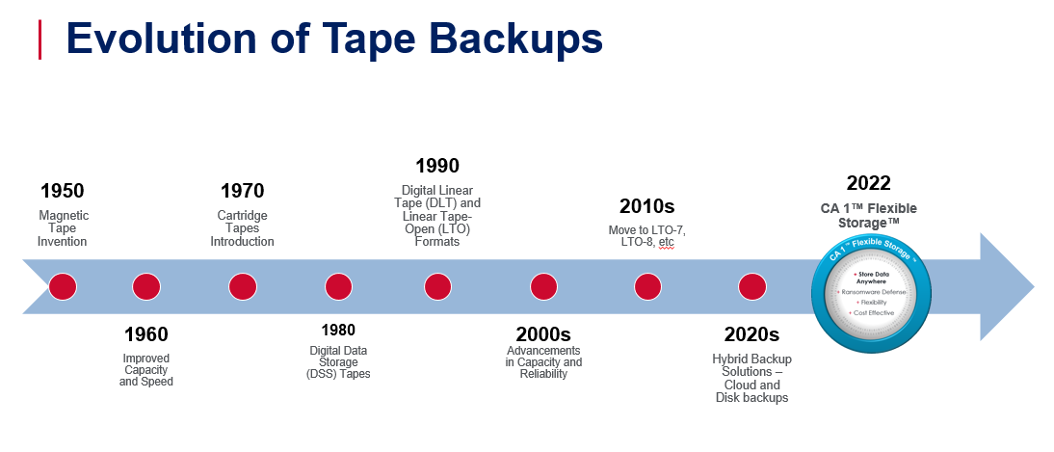This blog is the last in a three-part blog series, where we've explored the evolution of data within the vast landscape of enterprise storage. We began our journey in part one by unraveling the symbiotic relationship between mainframe enterprise data storage and the broader data lifecycle, understanding its evolution from creation to destruction. The second part brought us to the evolution and simplification of tiered storage, demonstrating how strategic implementation with a solution such as CA 1™ Flexible Storage™ can effectively address the challenge of data storage costs. Now, we turn our attention to Disk Backups versus Tape Backups.
Disk backups and tape backups are two common methods used in enterprise storage for data backup and recovery. Each approach has its own advantages and disadvantages, making them suitable for different use cases.
As we explore the advantages of tape backups, including low cost, scalability, offline storage, and longevity, we unravel the layers of sophistication in data archiving. Join us as we describe the optimal solution for preserving data integrity and accessibility in the ever-evolving landscape of mainframe enterprise storage solutions.
In the image below, you can see how tape backups have evolved over time.

The following is a description with the advantages and disadvantages of each type of mainframe data storage. You can use this information to make decisions about what data should be stored using one or both of the approaches.
Advantage: Disk backups are faster for both backup and recovery operations compared to tape backups. Data can be read and written sequentially or randomly with low latency, making it suitable for rapid data retrieval.
Disk backups also offer near-instant access to data, making them ideal for applications where downtime must be minimized.
Advantage: Disk-based systems are generally considered more reliable and less prone to physical damage than tape backups. They are less susceptible to environmental factors like temperature and humidity.
Advantage: Disk backups can easily manage multiple versions of data, making it easier to recover from different points in time. This is useful for data versioning and point-in-time recovery.
Advantage: Disk-based backup systems often come with built-in management and automation tools that simplify backup and recovery processes. This reduces the need for manual intervention.
Disadvantage: Disk storage is generally more expensive per terabyte compared to tape storage. Scaling disk-based backup systems can be cost-prohibitive for organizations with large data storage requirements.
Disadvantage: Disk backups are not as well-suited for long-term archiving due to their higher costs and potential for data degradation over time.
Advantage: Tape backups are typically more cost-effective for long-term data archiving and retention. Tapes are relatively inexpensive per terabyte of storage.
Advantage: Tape backups can be easily stored offline, making them less susceptible to cyberattacks or malware. This air-gapped storage enhances data security.
Advantage: Tape libraries can scale to accommodate large volumes of data in an economically efficient way. It's a preferred choice for organizations with massive data storage requirements.
Advantage: Tapes are physically durable and can withstand environmental conditions that might damage other storage media.
Advantage: Tapes have a longer shelf life compared to disk drives, making them suitable for archiving data for several decades.
Disadvantage: Tape backups are slower for data retrieval than disk backups. Retrieving data from tapes can be time-consuming, especially if they are not on the tape drive.
Disadvantage: Managing tape libraries can be more complex, and locating and retrieving specific data from tapes can be less intuitive compared to disk-based systems.
In summary, the choice between disk backups and tape backups for enterprise mainframe data storage depends on factors such as speed, cost, reliability, scalability, and long-term archiving needs. Many organizations use a combination of both methods, known as a hybrid approach, to balance the advantages of both disk and tape backup solutions to meet their diverse data backup and recovery requirements.
Broadcom works with many enterprises who navigate the complex terrain of storage solutions and find that CA 1 Flexible Storage is the most comprehensive solution that extends the conventional paradigms. With a focus on tape backups, CA 1 Flexible Storage offers a trifecta of advantages that include low cost, scalability, offline storage, and longevity.
CA 1 Flexible Storage embraces sophistication in data archiving. This solution not only enforces zero-trust through file-level encryption, but also integrates seamlessly into a robust cyber resilience strategy with immutable volumes, strict data retention policies, and S3 Object storage capabilities. The solution is unique in its ability to reduce batch backup windows, extend the life of existing storage solutions, and yield substantial cost savings, potentially reaching millions over traditional storage alternatives. If you're seeking a transformative approach to enterprise storage with unparalleled benefits, CA 1 Flexible Storage is the most innovative mainframe storage solution in recent history.
For more information on CA 1 Flexible Storage, reach out to your Broadcom representative to unlock the full potential of your storage environment.
 Copyright © 2005-2025 Broadcom. All Rights Reserved. The term “Broadcom” refers to Broadcom Inc. and/or its subsidiaries.
Copyright © 2005-2025 Broadcom. All Rights Reserved. The term “Broadcom” refers to Broadcom Inc. and/or its subsidiaries.
Comments